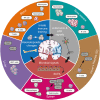Old Dog New Tricks; Revisiting How Stroke Modulates the Systemic Immune Landscape
- PMID: 31312180
- PMCID: PMC6614437
- DOI: 10.3389/fneur.2019.00718
Old Dog New Tricks; Revisiting How Stroke Modulates the Systemic Immune Landscape
Abstract
Infections in the post-acute phase of cerebral ischaemia impede optimal recovery by exacerbating morbidity and mortality. Our review aims to reconcile the increased infection susceptibility of patients post-stroke by consolidating our understanding of compartmentalised alterations to systemic immunity. Mounting evidence has catalogued alterations to numerous immune cell populations but an understanding of the mechanisms of long-range communication between the immune system, nervous system and other organs beyond the involvement of autonomic signalling is lacking. By taking our cues from established and emerging concepts of neuro-immune interactions, immune-mediated inter-organ cross-talk, innate immune training and the role of microbiota-derived signals in central nervous system (CNS) function we will explore mechanisms of how cerebral ischaemia could shape systemic immune function. In this context, we will also discuss a key question: how are immune requirements critical for mediating repair of the ischaemic insult balanced by the need for anti-microbial immunity post-stroke, given that they are mediated by mutually exclusive immune networks? Our reformed understanding of the immune landscape post-stroke and novel mechanisms at play could guide targeted therapeutic interventions and initiate a step-change in the clinical management of these infectious complications post-stroke.
Keywords: cerebral ischaemia; innate immune training; neuroimmunology; post-stroke infection; systemic immunity.
Figures

References
-
- Ovbiagele B, Hills NK, Saver JL, Johnston SC. California Acute Stroke Prototype Registry Investigators. Frequency and determinants of pneumonia and urinary tract infection during stroke hospitalization. J Stroke Cerebrovasc Dis. (2006) 15:209–13. 10.1016/j.jstrokecerebrovasdis.2006.05.004 - DOI - PMC - PubMed
Publication types
LinkOut - more resources
Full Text Sources

